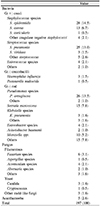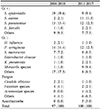Abstract
Purpose
We investigated the regional characteristics and trends in causative agents, clinical features, and antibiotic susceptibility in infectious keratitis in western Gyeongnam province.
Methods
This retrospective chart review included 551 eyes of 551 patients with infectious keratitis, who were referred to our center from January 2004 to December 2017. The period of this study was divided into two terms of 7 years before and after 2011 to analyze the changes in causative organisms and antibiotic susceptibilities and to investigate the clinical features and regional characteristics in western Gyeongnam province.
Results
The most common occupation among patients was farming; the mean time taken for initial treatment was 8.6 days. The culture positivity rate was 35.8%, the most commonly isolated microorganisms were Staphylococcus epidermidis (14.5%) for Gram-positive bacteria and Pseudomona aeruginosa (13.5%) for Gram-negative bacteria. The distribution of culture-positive organisms before and after 2011 did not show any significant difference, but the increase in resistance to second and third generation quinolones was significantly greater in Gram-positive bacteria after 2011. There was no significant difference in clinical characteristics before and after 2011, but the hospital stay duration and treatment needs were significantly reduced.
Conclusions
This was a large-scale study analyzing the clinical features of infectious keratitis in western Gyeognam province over a 14-year period. The results will help us understand the characteristics, microbiology, and community in infectious keratitis by analyzing patients referred to tertiary centers.
Figures and Tables
References
1. Thylefors B, Négrel AD, Pararajasegaram R, Dadzie KY. Global data on blindness. Bull World Health Organ. 1995; 73:115–121.
2. Chirambo MC, Tielsch JM, West KP Jr, et al. Blindness and visual impairment in Southern Malawi. Bull World Health Organ. 1986; 64:567–572.
3. Chirambo MC, Benezra D. Causes of blindness among students in blind school institutions in a developing country. Br J Ophthalmol. 1976; 60:665–668.

4. Brilliant LB, Pokhrel RP, Grasset NC, et al. Epidemiology of blindness in Nepal. Bull World Health Organ. 1985; 63:375–386.
5. Gilbert CE, Wood M, Waddel K, Foster A. Cause of childhood blindness in East Africa: results in 491 pupils attending 17 schools for the blind in Malawi, Kenya and Uganda. Ophthalmic Epidemiol. 1995; 2:77–84.
6. Lichtinger A, Yeung SN, Kim P, et al. Shifting trends in bacterial keratitis in Toronto: an 11-year review. Ophthalmology. 2012; 119:1785–1790.
7. Srinivasan M, Gonzales CA, George C, et al. Epidemiology and aetiological diagnosis of corneal ulceration in Madurai, South India. Br J Ophthalmol. 1997; 81:965–971.

8. Schaefer F, Bruttin O, Zografos L, Guex-Crosier Y. Bacterial keratitis: a prospective clinical and microbiological study. Br J Ophthalmol. 2001; 85:842–847.

9. Yeh DL, Stinnett SS, Afshari NA. Analysis of bacterial cultures in infectious keratitis,1997 to 2004. Am J Ophthalmol. 2006; 142:1066–1068.
10. Toshida H, Kogure N, Inoue N, Murakami A. Trends in microbial keratitis in Japan. Eye Contact Lens. 2007; 33:70–73.

11. Liesegang TJ, Forster RK. Spectrum of microbial keratitis in South Florida. Am J Ophthalmol. 1980; 90:38–47.

12. Hagan M, Wright E, Newman M, et al. Cause of suppurative keratitis in Ghana. Br J Ophthalmol. 1995; 79:1024–1028.
13. Gonawardena SA, Ranasinghe KP, Arseculeratne SN, et al. Survey of mycotic and bacterial keratitis in Sri Lanka. Mycopathologia. 1994; 127:77–81.

14. Zhang C, Liang Y, Deng S, et al. Distribution of bacterial keratitis and emerging resistance to antibiotics in China from 2001 to 2004. Clin Ophthalmol. 2008; 2:575–579.
15. Green M, Apel A, Stapleton F. A longitudinal study of trends in keratitis in Australia. Cornea. 2008; 27:33–39.

16. Hahn YH, Lee SJ, Hahn TW, et al. Antibiotic susceptibilities of ocular isolates from patients with bacterial keratitis: a multi-center study. J Korean Ophthalmol Soc. 1999; 40:2401–2410.
17. Hahn YH, Hahn TW, Tchah H, et al. Epidemiology of infectious keratitis (2): a multi center study. J Korean Ophthalmol Soc. 2001; 42:247–265.
18. Kim WJ, Kweon EY, Lee DW, et al. Prognostic factor and antibiotic susceptibility in bacterial keratitis: results of an eight-year period. J Korean Ophthalmol Soc. 2009; 50:1495–1504.

19. Kim JY, Yoon KC, Park YG, et al. Age-related clinical analysis of infectious keratitis in two tertiary centers. J Korean Ophthalmol Soc. 2010; 51:927–934.

20. Lim SH, Lee SB. Analysis of inpatients with bacterial keratitis over a 12-year period: pathogenic organisms and antibiotic resistance. J Korean Ophthalmol Soc. 2012; 53:372–384.

21. Kim MR, Lee SB. Clinical and microbiological analysis of grampositive bacterial keratitis, a 15-year review. J Korean Ophthalmol Soc. 2014; 55:1432–1444.

22. Cho EY, Lee SB. Gram-negative bacterial keratitis: a 15-year review of clinical aspects. J Korean Ophthalmol Soc. 2015; 56:1479–1488.

23. Mukerji N, Vajpayee RB, Sharma N. Technique of area measurement of epithelial defects. Cornea. 2003; 22:549–551.

24. Biemer JJ. Antimicrobial susceptibility testing by the Kirby-Bauer disc diffusion method. Ann Clin Lab Sci. 1973; 3:135–140.
25. Jorgensen JH, Hindler JF. New consensus guidelines from the Clinical and Laboratory Standards Institute for antimicrobial susceptibility testing of infrequently isolated or fastidious bacteria. Clin Infect Dis. 2007; 44:280–286.

26. Shin SY, Koo SH, Kwon KC, et al. Evaluation of the Vitek 2 Korean antimicrobial susceptibility testing cards AST N056 and AST N055. Korean J Clin Microbiol. 2008; 11:23–28.

27. Kim YS, Lee SB, Chung WS. The causative organisms and therapy of corneal ulcers. J Korean Ophthalmol Soc. 1994; 35:1171–1177.
28. Bourcier T, Thomas F, Borderie V, et al. Bacterial keratitis: predisposing factors, clinical and microbiological review of 300 cases. Br J Ophthalmol. 2003; 87:834–838.

29. Alexandrakis G, Alfonso EC, Miller D. Shifting trends in bacterial keratitis in South Florida and emerging resistance to fluoroquinolones. Ophthalmology. 2000; 107:1497–1502.





 PDF
PDF ePub
ePub Citation
Citation Print
Print










 XML Download
XML Download